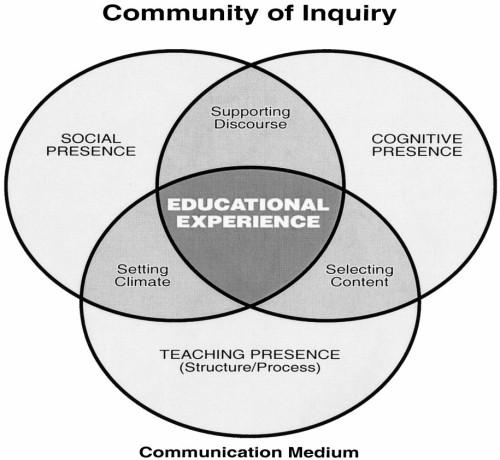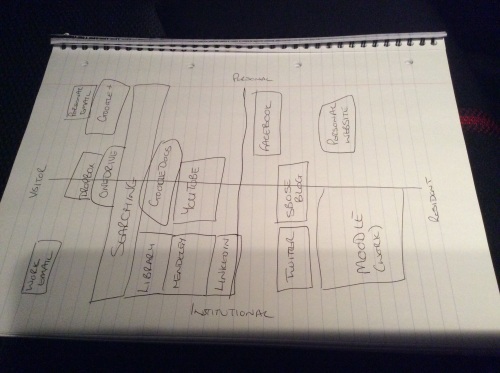
The module, Supporting the Blended and Online Student Experience, is drawing to a close and it is time for me to look back over the weeks and see what I have taken from this.
We looked at various areas throughout the module and I was particularly looking at it for my Distance Learning Programme. There were 2 main areas that particularly grabbed my attention, Digital Literacies and Online Social Presence. Don’t get me wrong, I did find all areas interesting but these 2 are ones I can “use” straight away while improving the distance learning programme. I also found the experience of designing a student led seminar very challenging but in a good way.
Digital Literacies
The activity of creating our own Visitor and Resident map and looking at my digital presence opened up my eyes to how much technology I am using in my professional and personal life and where these tools overlap. This is something I would like to do with my class based students and introduce them to some useful technology for their studies and getting them to share ideas on this. I am hoping this will get them to think about their digital footprint at the same time, which will be important as they will be coming to the end of their time at college and moving to University or employment. I want to also do this with my HNC Distance Learning Programme, but not sure when I would do this or how yet.
Digital Natives was a term I came across in the previous module and it outlines the assumptions made about the skills of the students coming into college/university based on their age. At the time I didn’t really question it but the literature in this module made me think and realise that we cannot make any assumptions about students abilities, especially when it comes to using online tools, just because they grew up in a time where technology surrounds them does not mean they can easily learn new or different technology.
Online Social Presence
This is something I have never really considered for my own practice till it was one of the themes our team’s seminar. It was interesting to see how small things can help to improve the tutor’s relationships with online students. This also goes for the relationships between students, something that has never really been thought about for the HNC programme by myself or previous tutors. I think the students getting to know each other will help them support each other, just like my on campus students, through their studies.
I am in the process of implementing a student induction unit where the student will hopefully start to develop their own online social presence and start to engage with each other and help each other out. I have managed to start this process with some students who have been studying with me for a while so are more comfortable with the online system and each other through the online meetings.
Another aim of the induction is to give the students a chance to use some of the features in Moodle that are in the course so that they are familiar with their functions before starting, meaning they can concentrate more on the content and not worrying about if they are submitting assignments correctly.
Student Led Seminars
The preparation of the student led seminars was a very challenging time, trying to juggle participating in the other groups seminars as well as designing our own one (on top of a full time teaching timetable), but surprisingly good. It is surprising how focused we were and the volume of work that was completed in the short period of time. I think the motivation was there as we would be assessed on this but I think in future projects I will be suggesting the online meetings/collaboration to focus everyone on the task.
This experience allowed me to develop an online unit with no prior materials and using the tools to allow a more engaging student experience, although this was at a much higher level than I am delivering, I found some useful tools and activities I can adapt to suit the student groups I have.
Overall…
What I am finding is the topics we are learning about I am able to put into practice straightaway without making major changes (although some are on the cards for the future). This is also having an impact on some of my fellow colleagues as they are seeing the positive outcomes from these small changes.
Although my motivation has diminished at time I am still determined to finish as I am seeing a positive change in my own working practices, which in turn has had a positive impact on my students so far.








 I think the first steps would be getting the student to upload a photo and add a bit of information about themselves to their profile page to give that sense that name on the computer screen is real (this is the bit I am “stealing” from the course). I will also need to develop my own social presence to show the student that yes I am human (regardless of how late I reply to emails and mark their work!) and this will hopefully help with the teacher presence element too. I will leave it up to them on how much they want to share about themselves but will ask them to revisit their profile periodically to see if they want to update any of the information or include more (oooh this could be included as part of the PDP process, cue light bulb moment!).
I think the first steps would be getting the student to upload a photo and add a bit of information about themselves to their profile page to give that sense that name on the computer screen is real (this is the bit I am “stealing” from the course). I will also need to develop my own social presence to show the student that yes I am human (regardless of how late I reply to emails and mark their work!) and this will hopefully help with the teacher presence element too. I will leave it up to them on how much they want to share about themselves but will ask them to revisit their profile periodically to see if they want to update any of the information or include more (oooh this could be included as part of the PDP process, cue light bulb moment!).


 This is something that I have been trying to pin point since starting this course. I must admit I am not the best at studying without the traditional face-to-face interaction. I have been delivering a distance learning program for a few years now, but in the beginning I did not understand (or appreciate) what it took for my learners to complete the course work and assessments without that regular contact. Through experience and working with the learners I have come to appreciate the amount of work and the juggling act they need to do to complete the work I have asked them to do.
This is something that I have been trying to pin point since starting this course. I must admit I am not the best at studying without the traditional face-to-face interaction. I have been delivering a distance learning program for a few years now, but in the beginning I did not understand (or appreciate) what it took for my learners to complete the course work and assessments without that regular contact. Through experience and working with the learners I have come to appreciate the amount of work and the juggling act they need to do to complete the work I have asked them to do.